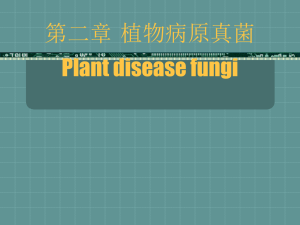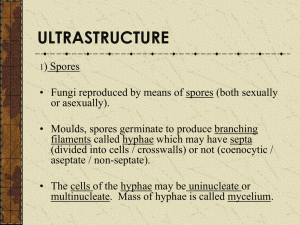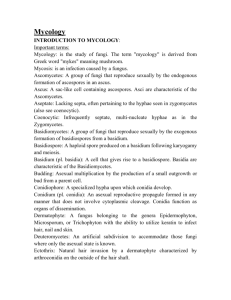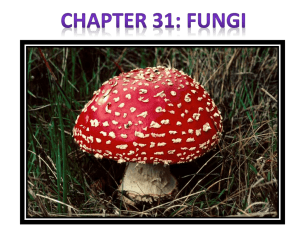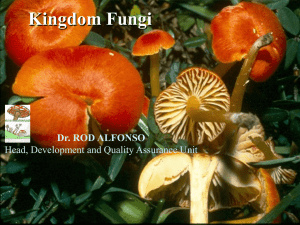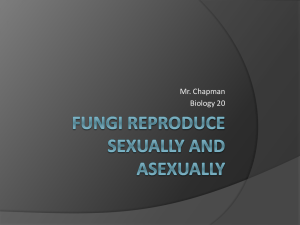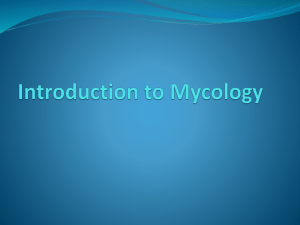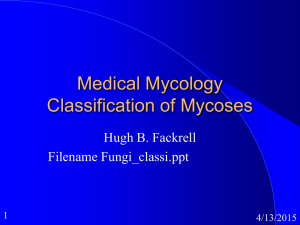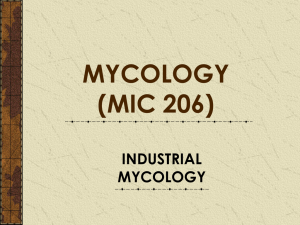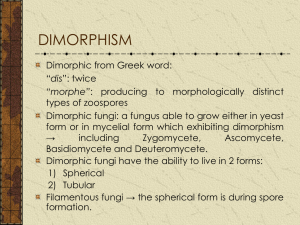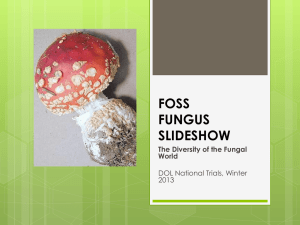Intro to Fungi
advertisement
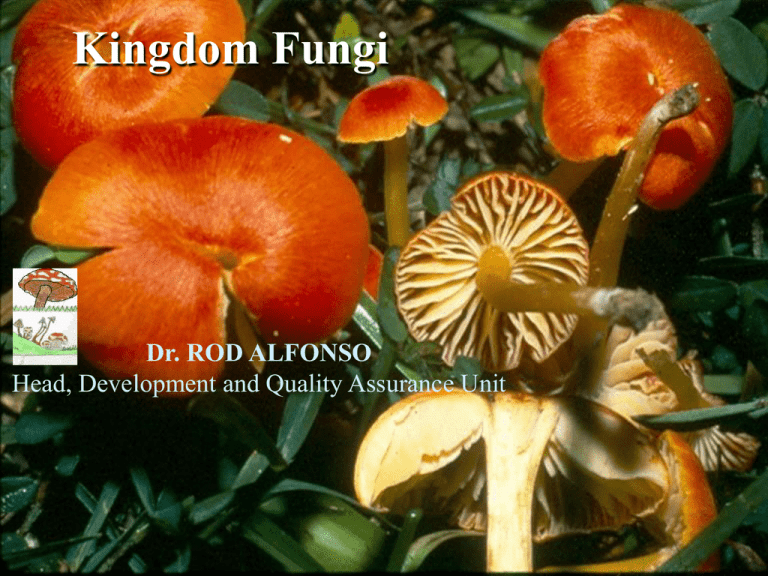
Kingdom Fungi Dr. ROD ALFONSO Head, Development and Quality Assurance Unit Requirements to get Good Grade 1. Perfect Attendance 2. Participate actively in classroom activities 3. Pass assignment on time 4. Pass all quizzes and major exams 5. Good attitude Learning Objectives At the end of the lesson, students will be able to: 1. Define mycology; Define a fungus 2. Describe the characteristics of fungi 3. Describe the distribution of fungi in nature 4. Explain why there are few invasive fungal infection. 5. 6. Describe the characteristics of yeasts and how they reproduce Discuss the significance of yeast in food industry, in medicine and biofuel industry. 7. Describe molds 8. Differentiate hypha, thallus and mycelium 9. Differentiate between septate and coenocytic hyphae 10. Explain dimorphic fungi 11. Discuss the beneficial and harmful effects of fungi Mycology Mycology is the study of fungi ( yeasts, molds and mushrooms) 001 What is a fungus? • A eukaryotic, heterotrophic organism devoid • • of chlorophyll that obtains its nutrients by absorption, and reproduces by spores. The primary carbohydrate storage product of fungi is glycogen. Most fungi have a thallus composed of hyphae (sing. hypha) that elongate by tip growth The Characteristics of Fungi * Eukaryotic(true nucleus) * Larger, more complex than bacteria * Lack chlorophyll * Chitin, glucan & mannan are the complex carbohydrates found in their cell wall * Reproduce sexually and asexually * Cell wall contains ergosterol * Heterotrophic (require organic carbon) Fungal Fast Facts • Fungi are all • • around us We touch them, we swallow them, we breathe them There are more than 1.5 million fungal species in nature • Yet only about 100 • • cause human disease Most cause superficial infections, some cause allergic reactions Few cause invasive infections Why so few Invasive Infections? Host/Pathogen Balance: Normal Circumstances Anatomical barriers Host Factors Protection Adaptive immunity Virulence Fungal Factors Fungal Burden Innate defenses Infection Yeast - Major Characteristics • • • Unicellular Fungi, nonfilamentous, oval or spherical cells Eukaryotic Facultative anaerobes * When oxygen is available, they carry out aerobic respiration. * When oxygen is not available, they ferment carbohydrates to produce ethanol and carbon dioxide. • Capable of forming colonies on solid culture media (see pictures on the right). Yeast - Reproduction They reproduce either asexually (most common) or sexually. •Asexual reproduction is through budding or binary fission. •Sexual reproduction (if any) results in the formation of the appropriate spore structure. Fission Budding Saccharomyces cerevisiae Spores Schizosaccharomyces octosporus Yeast Significance Food Industry • Fermentation of bread, beer, and wine. E.g. Saccharomyces cerevisiae (also called baker’s yeast or sugar yeast) used in baking and fermenting of alcoholic beverages. Medical • E.g. Candida albicans - common in the human mouth, but can become pathogenic and cause Candidiasis (oral and/or genital infection). Biofuel Industry •Production of ethanol for car fuel. 2. Molds and Fleshy Fungi Multicellular, filamentous fungi. Identified by physical appearance, colony characteristics, and reproductive spores. * Thallus: Body of a mold or fleshy fungus. Consists of many hyphae. * Hyphae (Sing: Hypha): Long filaments of cells joined together. Septate hyphae: Cells are divided by cross-walls (septa). Coenocytic (Aseptate) hyphae: Long, continuous cells that are not divided by septa. Hyphae grow by elongating at the tips. Each part of a hypha is capable of growth. Vegetative Hypha: Portion that obtains nutrients. Reproductive or Aerial Hypha: Portion connected with reproduction. * Mycelium: Large, visible, filamentous mass made up of many hyphae. Characteristics of Fungal Hyphae: Septate versus Coenocytic Hyphae • Tubular • Hard wall of chitin • Crosswalls may • • form compartments (± cells) Multinucleate Grow at tips Hyphal growth • Hyphae grow from their tips • Mycelium = extensive, feeding web of hyphae • Mycelia are the ecologically active bodies of fungi This wall is rigid Only the tip wall is plastic and stretches Mycelium: Large, Visible Mass of Hyphae Dimorphic Fungi Can exist as both multicellular fungi (molds) and yeasts. Many pathogenic species. Mold form produces aerial and vegetative hyphae. Yeast form reproduces by budding. Dimorphism in pathogenic fungi typically depends on temperature: At 37oC: Yeast form. At 25oC: Mold form. Yeast at 370C Mold at 250C Dimorphism in nonpathogenic fungi may depend on other factors: Carbon dioxide concentration. HUMAN-FUNGUS INTERACTIONS • • Beneficial Effects of Fungi * Decomposition - nutrient and carbon recycling. * Biosynthetic factories. Can be used to produce drugs, antibiotics, alcohol, acids, food (e.g., fermented products, mushrooms). * Model organisms for biochemical and genetic studies. Harmful Effects of Fungi * Destruction of food, lumber, paper, and cloth. * Animal and human diseases, including allergies. * Toxins produced by poisonous mushrooms and within food (e.g., grain, cheese, etc.). * Plant diseases.
